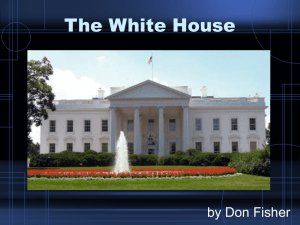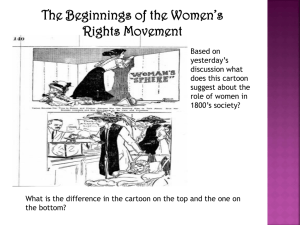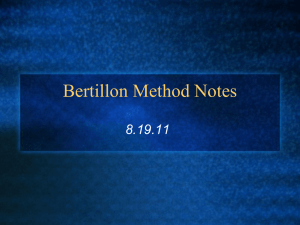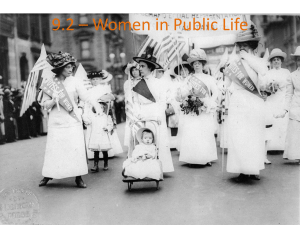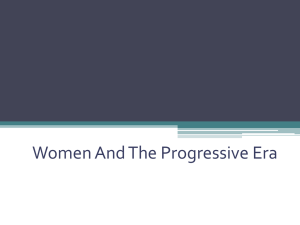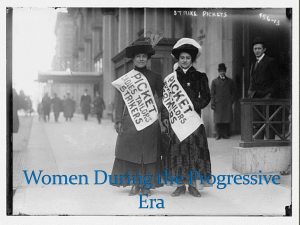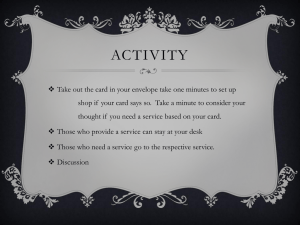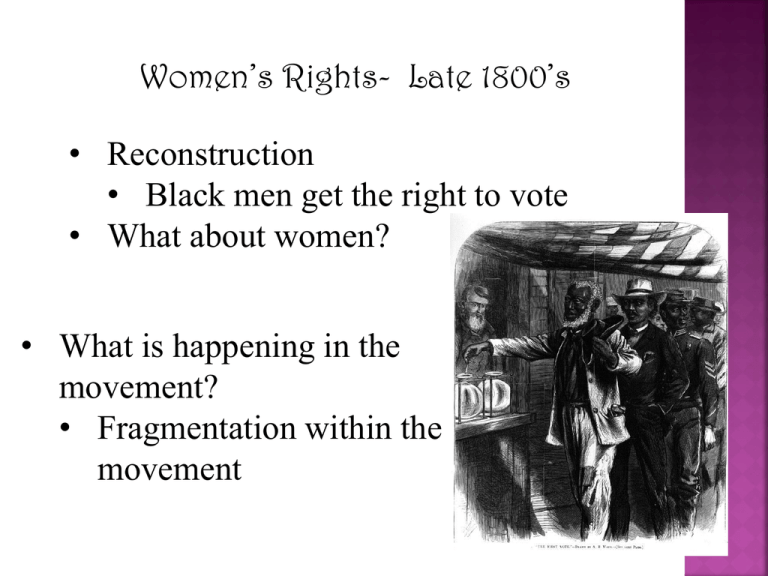
Women’s Rights- Late 1800’s
• Reconstruction
• Black men get the right to vote
• What about women?
• What is happening in the
movement?
• Fragmentation within the
movement
Women’s Rights- Late 1800’s
• The Fifteenth
Amendment?
• What was it?
• Some believed it
should include
women
• Others believed
that if it was
attached then
the Amendment
would fail
Women’s Rights- Late 1800’s
• 1869 The movement fragments into
three distinct groups:
• American Women Suffrage
Association (AWSA)
• National Woman Suffrage
Association (NWSA)
Women’s Rights- Late 1800’s
• AWSA
• Founded in 1869
American Woman Suffrage Association
• Lucy Stone, Henry Blackwell, Julia Ward Howe
• Felt that suffrage should not be included in
the 15th Amendment
Women’s Rights- Late 1800’s
• NWSA
• Founded in
1869
National Woman Suffrage Association
• Elizabeth Cady Stanton, Susan B. Anthony
• Felt that suffrage should be included in
the 15th Amendment
• First victory in 1869 when Wyoming
Territory extended the vote to women.
Women’s Rights- Late 1800’s
• NWSA
• Founded in
1869
• Elizabeth Cady Stanton, Susan B. Anthony
• Promote women to vote illegally,
beginning in 1870
• 1872-1873 Arrest and prosecution
of Susan B Anthony
Women’s Rights- Late 1800’s
• Third faction to form in the movement
• Colored Woman’s
Progressive Franchise
Association
• Founded in 1871
• Mary Ann Shadd Cary
Women’s Rights- Late 1800’s
Notable court cases:
1873 Bradwell v. Illinois
• Myra Bradwell challenges to practice
law.
• The verdict: DENIED
Women’s Rights- Late 1800’s
Notable court cases:
1875 Minor v. Happersett
• Argued for right to vote…all the way to
the Supreme Court
• The verdict: DENIED
• However…the ruling did define women
as “Citizens” and “persons”
Women’s Rights- Late 1800’s
December 23, 1873 WCTU is formed
Women’s
Christian
Temperance
Union
The purpose of the WCTU was to
create a “sober and pure world” by
abstinence, purity and evangelical
Christianity.
Women’s Rights- Late 1800’s
Frances Willard was the 2nd president of the
WCTU
Motto: "Do everything"
The motto was for the women
of the WCTU to incite
lobbying, petitioning,
preaching, publication, and
education.
Women’s Rights- Late 1800’s
• As the movement grew in numbers and strength,
members of the WCTU also focused on suffrage.
• The WCTU was instrumental in organizing
woman's suffrage leaders and in helping more
women become involved in American politics.
• Willard pushed for the "Home Protection" ballot,
arguing that women, being the superior sex
morally, needed the vote in order to act as
"citizen-mothers" and protect their homes and
cure society's ills.
Women’s Rights- Late 1800’s
• At a time when suffragists still alienated most
American women, who viewed them as radicals,
the WCTU offered a more traditionally feminine
and appropriate organization for women to join.
Women’s Rights- Late 1800’s
Women in higher education
• Women did begin to go to college after the
Civil War, and for the most part they went
to coeducational institutions
• Admitted 4 women in 1837.
• Mary Kellogg (Fairchild), Mary Caroline
Rudd, Mary Hosford, and Elizabeth Prall.
• All but Kellogg graduated.
• Mary Jane Patterson graduated in 1862 to
become the first black woman to earn a
B.A. degree.
Women’s Rights- Late 1800’s
Women in higher education
• Those that opposed women in higher
education claimed:
• "...a girl could study and learn, but she
could not do all this and retain uninjured
health, and a future secure from neuralgia,
uterine disease, hysteria, and other
derangements of the nervous system,"
according to Dr. Edward Clark in his widely
respected Sex and Education published in
1873.
Women’s Rights- Late 1800’s
Women in higher education
• Those that opposed women in higher
education claimed:
• “...the pathetic impossibility of
improving those poor little, hard, thin,
wiry, one-stringed instruments which
they call their minds.”

